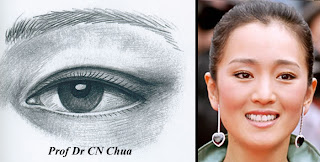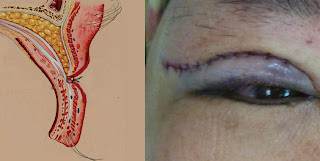Double eyelids are present in about 50% of Chinese, however, their shapes are distinctly different from that of Caucasian. The types of double eyelids seen in Chinese can be broadly divided into the tapering type (开扇形) and the parallel type (平行型). In the tapering type, the double eyelid is joined to the edge of the eyelid at the nasal (inner) side and becomes progressively higher as it moves temporally (outside). In the parallel type, the double eye (skin crease) runs parallel to the eyelid edge along its full length. A study in China found that tapering type accounts for 80% of Chinese who have double eyelids and the parallel type 20%.
The other type of double eyelid which is rare in Chinese but typical of Caucasians is the semilunar type (新月形) in which the double eyelid is highest in the centre and lower at both the nasal (inner) and temporal (outer) corners. Below are some more examples.
Tapering double eyelid
Parallel double eyelid
Semilunar double eyelid

















































